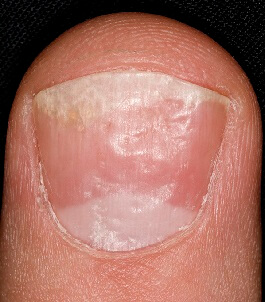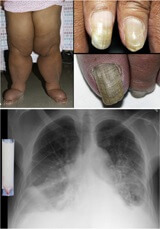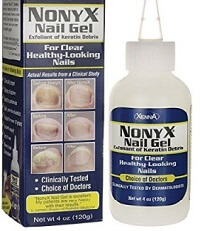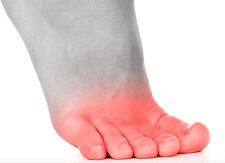- Home
- Foot Pain Symptoms
- Thick Toenails
Thick Toenails
Written By: Chloe Wilson BSc(Hons) Physiotherapy
Reviewed By: FPE Medical Review Board
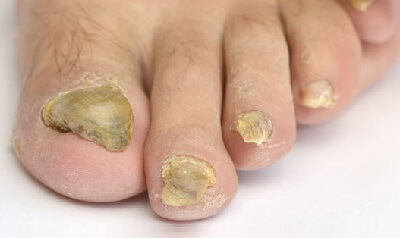
Thick toenails are a common problem, particularly in the elderly population.
It can be tempting to ignore thick toe nails, hoping that they will get better on their own, but they are usually an indication of an underlying problem that needs some intervention.
Thick toenails usually respond well to treatment, but the earlier it is started the better otherwise the nails can become extremely brittle.
What Causes Thick Toenails?
There are a number of different things that can cause thick toenails to develop, some which are more common than others.
If discoloration is more of a problem than thickening in your toenails, visit the Yellow Toenails section.
1. Fungal Nail Infection
Fungal nail infections are the most common cause of thick toenails, accounting for almost half of all nail-related problems. Around 10% of the population of the States suffer from toenail fungus infections.
Fungal infections typically affect the toenails but can in some instances affect the fingernails as well. The medical term for a fungal nail infection is onychomycosis or tinea unguium.
Fungal Nail Symptoms
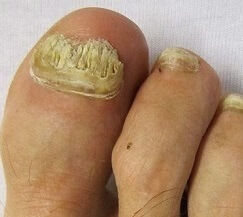
Fungal nail infections usually develop first on the edge of the nail and gradually spread to the middle of the nail.
The nail gradually thickens and may become discoloured, usually yellow, white, brown or black.
Thickened toenails from fungal infections become more brittle as they thicken and small pieces may crumble or break off.
As the toenail fungus infection gets worse, pain and swelling may develop in the skin underneath and around the nail. The nail may lift up from the nail bed and there may be an unpleasant odor due to the infection.
What Causes Toenail Fungus?
Thick nail fungus from onychomycosis is usually due to Dermatophytes (most common in temperate western countries), Candida or Non Dermatophytic Molds (most commonly affecting people who live in hot, humid climates).
It is normal to have microscopic fungi on your skin but sometimes this can lead to infection. Thickened toenail fungus infections are typically caused by:
- Nail Injury: damage to the nail allows the fungus to invade and infect the nail
- Fungal Foot Infection: a nearby fungal infection e.g. athlete's foot can spread to the nail causing thick toenails
- Poor Foot Hygiene: failing to keep the feet clean and dry
- Shoes: tight shoes, or ones that don’t allow your feet to breathe leading them to become hot and sweaty are the ideal breeding ground for fungi
- Walking Barefoot: in areas prone to fungal infection such as swimming pools, public showers and gyms
- Aging: infections most commonly affect people over the age of 60 as nails naturally thicken and grow slower, the blood supply diminishes and there is increased susceptibility to infection
- Weakened Immune System: from illness or medication
- Health Conditions: such as diabetes, circulatory problems and psoriasis
Thick toe nails from fungus infections can be highly contagious so it is important to take steps to prevent spreading the infection by keeping your feet clean, dry and covered.
2. Nail Psoriasis
Another possible cause of thick toe nails is psoriasis. Psoriasis is a common skin condition that can also affect the nails, leading to thick nails with areas of pitting, ridging, or abnormal contour.
Psoriasis of the nails is accompanied by skin psoriasis in approximately 95% of cases, with the classic feature of patches of red, crusty, flaky skin covered with silvery scales, typically on the elbows, knees and scalp and trunk.
Psoriasis is thought to be caused by a problem with the immune system which causes an increase in the production of skin cells.
Symptoms of Nail Psoriasis
Typical symptoms of thickened toenails caused by Psoriasis include:
- Discolouration: Nails may turn yellow, green or brown and there may be a small red or white spot that looks like a drop of blood or oil underneath the nail
- Appearance: There may be pitting in the nail which looks like small pinprick holes (caused by a loss in cells from the nails surface), ridges or grooves (that run across the nail rather than up and down) and you may develop thick toenails if there is an infection. White, chalky debris may also build up under the nail, known as subungual hyperkeratosis
- Nail Lifting: In some cases, the thick toenail may lift up off, or separate from, the nail bed, starting from the tip and extending towards the root of the nail. This is known as onycholysis
Other Causes of Thick Toenails
There are a number of other things that can cause thick toenails such as:
1. Paronychia
Paronychia is a nail disease caused by a bacterial infection at the side or base of the nail. Thick toe nails from paronychia may develop suddenly or gradually.
With Paronychia, the skin around the nail is usually red, inflamed, hot and painful and there is gradual thickening and discoloration of the nails and pus around the nail.
Paronychia can affect the fingernails or toenails and results in thick skin around the nails as well as thickening of the nails themselves.
2. Diabetes
Another possible cause of thick toe nails is Diabetes. Foot problems are common in people with type 2 diabetes due to the poor circulation and nerve damage associated with the condition. The nails do not receive the necessary nutrients to grow properly which can lead to blackened, thickened toenails.
Good foot care is vital for anyone who suffers from Diabetes and if you notice anything unusual, even if it seems fairly minor, you should seek medical advice immediately.
3. Ram’s Horn
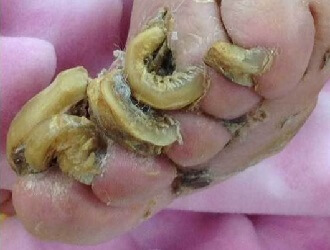
Another possible cause of thick toenails is Ram’s Horn, aka onychogryphosis, a condition most commonly seen in the elderly.
With onychogryphosis, overgrowth of the toenails leads to discoloured, deformed (typically curved), thickened toenails that gradually curl to resemble a ram’s horn.
Thick toenails from Ram's Horn typically develop due to cell damage from wearing tight, ill-fitting shoes, decreased blood supply to the nail, trauma/injury (such as dropping something heavy on the foot), infection, poor foot hygiene and failure to regularly trim the toenails.
Onychogryphosis usually need to be treated by a podiatrist as the nails become too thick to cut with conventional scissors or clippers. The nail may need removing altogether using the chemical phenol or a carbon dioxide laser.
4. Toe Injury
Repetitive minor trauma or pressure on the nail can result in thickened toenails. This commonly affects athletes and runners or people who wear tight, ill-fitting shoes. Alternatively, a more major injury, such as stubbing your toe or dropping a heavy object onto the toe can lead to thick toenails, particularly if the nail bed is damaged.
5. Yellow Nail Syndrome
Yellow nail syndrome is a rare condition that causes thick, dicoloured toenails and fingernails. Nails become thick, yellow and excessively curved.
There may be accompanying swelling in the arms and legs (lymphedema), as well as respiratory problems such as bronchiectasis, persistent coughing and pleural effusion (fluid build-up around the lungs).
6. Aging
Thick toenails are more common in the older population. As we get older, nails grow slower but this can lead them to thickening due to the piling up of nail cells, known as onychocytes. Repeated pressure on the feet and reduced circulation can also lead to thick toenails in the aging population.
Thick Toe Nail Treatment
There are lots of different thick nail treatment options:
- Anti-fungal Medications: either in the form of tablets or a special paint or drops that you apply directly to the nail. Anti-fungal medication takes a while to works and people usually need to continue with these for a number of months until symptoms completely resolve.
- Nail Removal: Either done surgically or with chemicals. This gives direct access to the nailbed and any thick skin under the nail which aids healing
- Laser Therapy: Using infrared radiation to produce heat which kills the fungi that causes thickened toenails. There are various mini nail fungus laser devices that you can get to use at home that can be really effective
- Natural Remedies: Tea tree oil is often used to treat fungal nail infections. Many people report finding it beneficial but there is limited research to support its use
- Systemic Medication: If you have both skin and nail psoriasis you will be given medication that is for the whole body such as methotrexate
- Phototherapy: UV light can be helpful in treating both skin and nail psoriasis
- Trimming Thick Nails: It can really help to keep on top of thick toe nails but keeping the trimmed. This can become quite a challenge as the toe nail thickens more, so you may need a special pair of toenail clippers for thick nails
- Nail Creams: to rub into and around the nail such as corticosteroid cream, vitamin D or anti-metabolites
- Injections: Corticosteroid injections under the nail can help to treat thick toe nails – these can be more effective than creams and can be done every few months
Recovering From Thick Toenails
Depending on the cause of your thick toenails, recovery can take anywhere from several days to several weeks. The length of recovery will depend on the severity of the issue, how long your nails have been thickening for, the underlying cause and how closely you follow the recommended treatment plan.
Some cases of thick toenails can be left to heal naturally without any treatment, simply by following good foot hygiene methods and keeping your feet clean and dry.
To speed up recovery from thick toenails you should also regularly trim and file your nails, use an anti-fungal solution (if appropriate), and apply moisturizers or oil to keep your toe nails soft. It’s also important to wear comfortable, breathable shoes that fit properly so that you aren't irritating your thick toenails further.
Your doctor may take a swab from under your nail or a toenail clipping and send it off for analysis to look for any sign of fungal infection before starting you on medication for your thickened toenails.
Prevention
It can take many months for painful, thick toenails from fungal infections to settle, and the recurrence rate is relatively high at between 10-50%. This makes prevention all the more important. Things you can do help reduce the risk of developing thickened toenails from fungal infections include:
- Good Foot Hygiene: Keep feet clean and dry, and keep nails trimmed
- Appropriate Footwear: Wear clean, cotton socks and good-fitting shoes that allow your feet to breathe
- Avoid Going Barefoot: In public areas such as showers and swimming pools
- Don’t Share: Use your own towels, footwear and nail clippers/scissors so as to prevent the spread of infections – if visiting a salon for a pedicure, ensure that all equipment is sterilised between uses
Psoriasis is not contagious so you don’t need to worry about passing on an infection from thick toenails if they are caused by psoriasis, unless there is an accompanying fungal infection.
Thick Toe Nails Summary
There are lots of possible causes of thick toe nails but the most common by far is a fungal infection.
Thickened tonails may be accompanied by thick skin under the nail or around it and the nails may also start to discolor, typically turning yellow.
Thick nails can usually be treated with a variety of nail care routines. You should start by using a manicure tool to gently trim your nails and then apply a moisturizer or oil to soften them. You can also apply over-the-counter antifungal solutions or home treatments such as apple cider vinegar or tea tree oil. If you are still having issues with your thick toenails, you may need to visit your doctor for additional diagnosis.
You may also be interested in the following articles:
- Toe Pain Causes & Treatment
- Yellow Toenails
- Toe Lumps
- Pain On Top Of Foot
- Foot Arch Pain
- Swollen Feet & Ankles
- Foot Numbness
- Why Are My Feet Red?
Related Articles
Page Last Updated: 23rd January, 2025
Next Review Due: 23rd January, 2027
